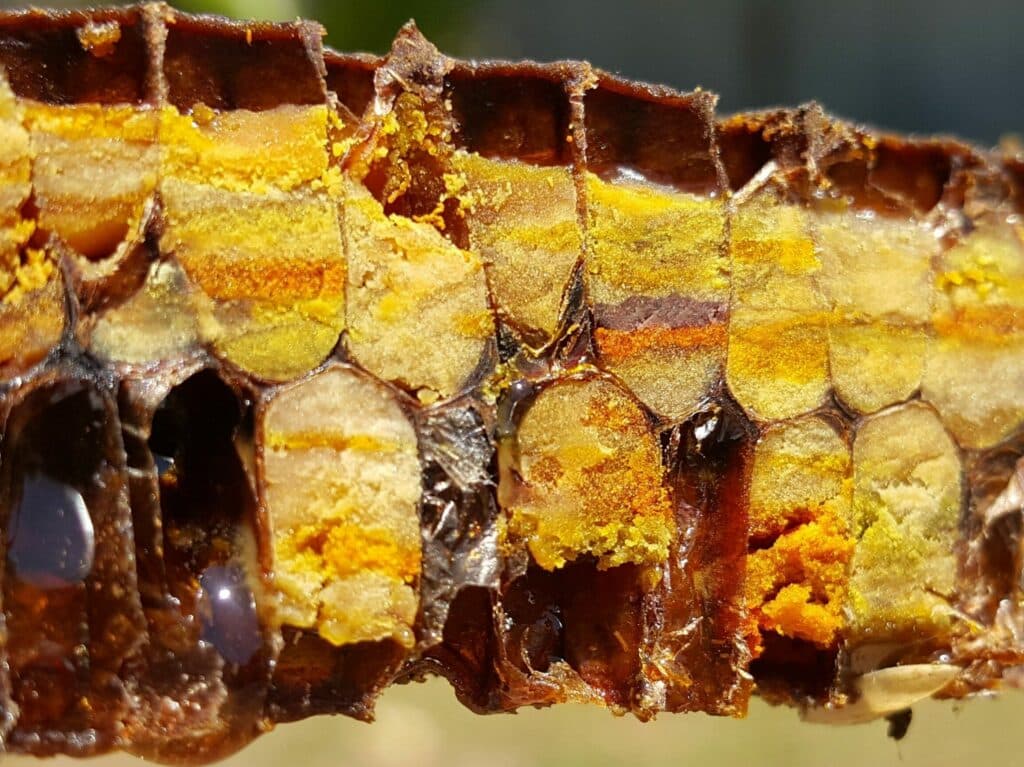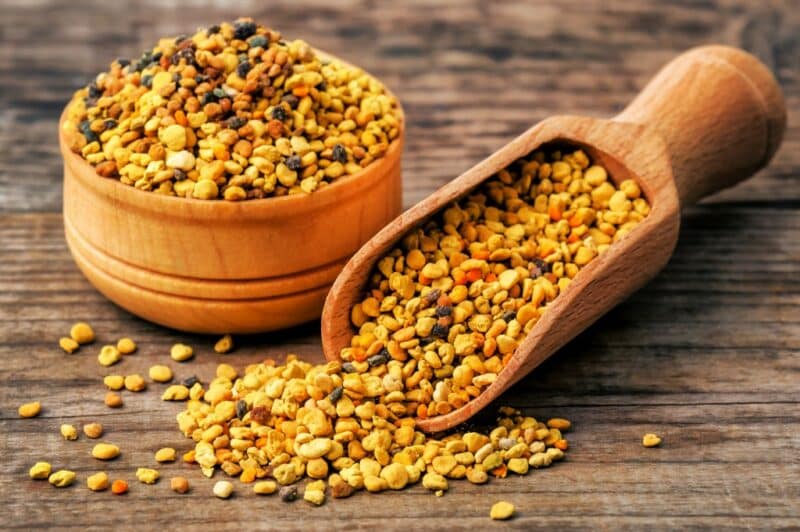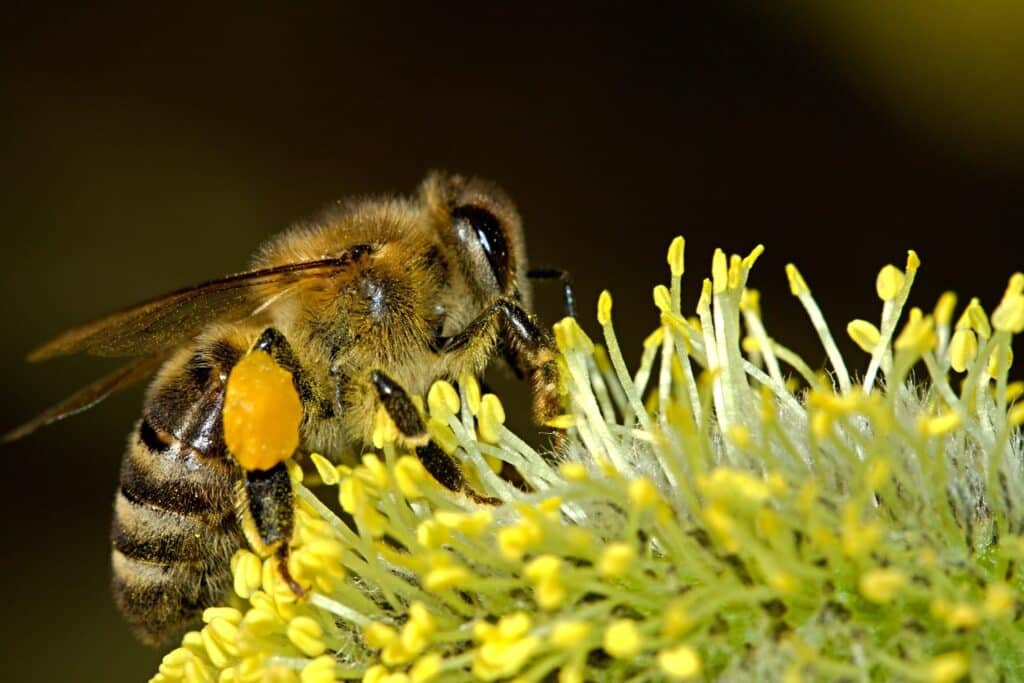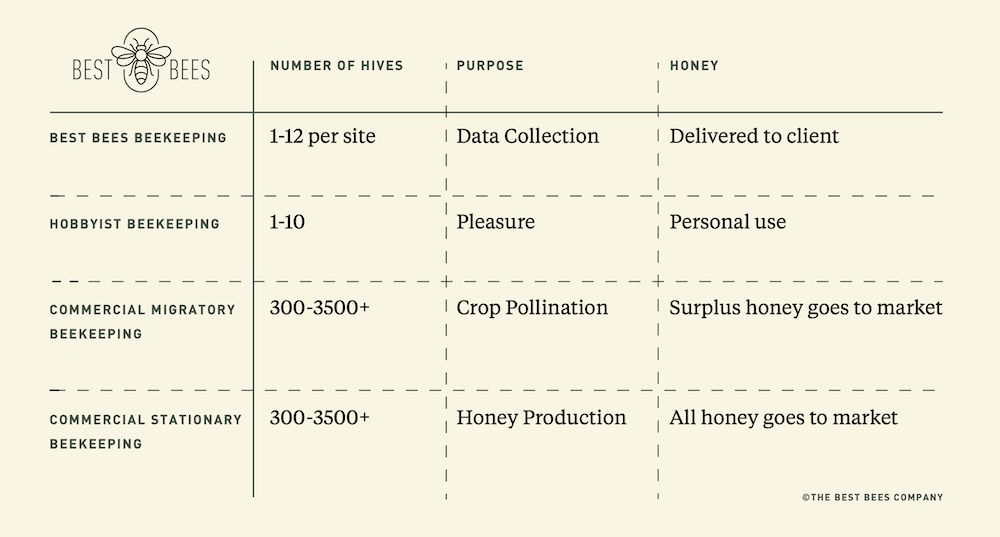Contents:
- What is Bee Pollen
- Why Bees Need Pollen
- Why Bees Make Bee Bread
- How Bees Make Bee Bread
- History of Bee Pollen and Humans
- Benefits of Bee Pollen and Bee Bread
- How Beekeepers Harvest Bee Pollen
- FAQs
What Is Bee Pollen?
Pollen is the powdery substance produced by the stamen of seed plants; it is essential for plant reproduction. Pollination is the process by which pollen, containing the male gametes, fertilizes the ovules of the female pistil of the plant, resulting in the production of seeds.
–– We pioneered the process of identifying the exact percentage of various pollen species found in honey through advanced genomic sequencing. Learn more on our Research page ––
Bee pollen is regular plant pollen that has been successfully harvested by bees and stored in their pollen baskets for their journey back to the hive. A pollen basket, or corbicula, is the structure on the outer hind leg of worker honey bees that holds the pollen. A different structure on the bees’ hind legs, called the pollen press, turns the pollen into small round, hard nuggets called pollen pellets. A bee can fit as many as 160,000 pollen grains in each pollen pellet!
As bees visit flowers while foraging for pollen or nectar, the fur on their bodies pick up pollen grains. If a bee is foraging for pollen, she will scrape this pollen onto the inside of the hind leg, then comb the pollen from there into the pollen press. The pollen press is the joint between the tibia and the basitarsus segments of the bee’s hind leg.
When a bee bends her leg, the tibia and the basitarsus pull apart, opening the pollen press up to be filled with pollen. When she straightens her leg, the segments close against the pollen and force it up into the pollen basket. During this process, the pollen is moistened with saliva and nectar, which helps the pollen stick together and maintain the pellet shape. The long hairs on bees’ legs hold these pellets in place as they fly.
Bees detect and choose pollen by odor and visual cues, such as the colors of the flower and its pollen. A typical-size honey bee colony – approximately 20,000 bees – collects about 125 pounds of pollen per year. A single bee can carry up to 35% of their body weight in pollen!
Why Bees Need Pollen
Honey bees have similar basic nutritional requirements to humans. They need proteins, (amino acids), carbohydrates, minerals, fats/lipids, and vitamins. Nectar, converted to honey, provides their carbohydrates and various minerals, such as calcium, copper, potassium, magnesium, and sodium, but the presence and concentration of minerals in nectar varies by floral source.
Pollen is the honey bees’ main source of protein, and it also provides fats/lipids, minerals, and vitamins. Protein is composed of amino acids, 10 of which have been identified as essential to honey bees. The nutritional needs of honey bees change slightly depending on their age and role within the hive and their exposure to the queen bee’s pheremones. Foragers require diets higher in carbohydrates, whereas nurse bees need higher levels of amino acids in order to produce royal jelly.
Pollen from different floral sources has different amounts and types of amino acids, fats, minerals, and vitamins – not all pollen is equally nutritious! This is important to keep in mind when planting for pollinators, either in personal gardens, public green spaces, or urban planning. It’s also why monoculture, the agricultural practice of growing acres upon acres of the same crop, is so detrimental for honey bee health.
Pollen grains harvested from the flower have strong, exterior cellulose barriers, which makes it difficult to digest for forager bees, who no longer produce the enzyme necessary to break down cellulose. Raw pollen is also not shelf-stable; it is technically a living product, high in moisture and protein. Those factors, plus the warmth of the interior of the hive, facilitate mold growth. So the bees take the pollen back to the hive and make a fermented, enzymatically-activated substance called bee bread.
Why Bees Make Bee Bread
Bee bread is pollen that has been moistened by a mixture of honey, nectar, bee saliva, and glandular secretions and fermented by microorganisms such as yeast, bacteria, and fungi. Through this fermentation and partial digestion process, the proteins improve in quality and digestibility, many vitamins increase in value, antioxidant concentrations and enzyme levels are elevated, and the nutrient reserves in pollen, such as zinc, magnesium, and silica, are made plentifully available through the breaking down of the cellulose.
Bee bread constitutes the main source of proteins, lipids, vitamins, and macro/microelements in honey bee nutrition – bees prefer to feed on bee bread rather than freshly collected pollen. It is a crucial nutrient source for the development of brood.
The youngest worker bees, nurse bees, eat bee bread to help finish the development of their hypopharyngeal glands, which produce royal jelly. The nurse bees feed this royal jelly to the larvae. Workers and drone larvae are only fed royal jelly for three days, after which the nurse bees switch to feeding them bee bread.
In addition to having superior nutritional value, bee bread also has greater storage longevity than raw bee pollen. “Because it’s fermented, it will last a long time,” says Emily O’Neil, Best Bees Staff Scientist.
Long-term preservation is the primary goal of turning bee pollen into bee bread; it’s critical for honey bees to have food stores within the hive. We’ve talked about honey stores, but bee bread stores are equally as important. The colony needs to bee bread to feed to the new brood once the winter ends, and they also need it for pollen-scarce times during the rest of the year.
How Bees Make Bee Bread

When the forager bee goes back to the hive, they deposit their pollen load into cells of the comb. Middle-aged, pollen processor worker bees pack the pollen down and add their microbiota, glandular secretions and nectar from their honey crops – the special honey “stomach” that bees store nectar in, mixing it with enzymes that break the complex sugars down into simple ones.
It takes multiple layers of packed-down pollen loads to fill the cell about three-quarters of the way full. Once it hits that level, the bees seal the cell with a layer of honey, under which the layers of pollen (mixed with all aforementioned elements) ferment into bee bread. These layers of pollen can come from many different floral sources, resulting in layers of different colors within the cell.
“It’s really cool – if you cut the individual cell in half, you can see the stripes of yellow, orange, white, brown, and other colors that show the different types of pollen,” says Emily O’Neil. The top layer of pollen will vary in color from cell to cell, resulting in frames featuring beautiful patterns.
One of the important bacterias involved in making bee bread is Lactobacillus genus, which metabolizes the fructose in the mixture of pollen and nectar and produces lactic acid. According to Emily, the production of lactic acid decreases the pH of the bee bread and creates the perfect environment for the next step of the fermentation process, which is done by yeast. The yeasts help preserve bee bread and stop pathogenic (bad) yeasts from growing and spoiling it.
History of Bee Pollen and Humans
Humans have been using and consuming honey bee products for generations. We love honey in our tea, beeswax to make candles and lip balm, royal jelly in skin care, and propolis in tinctures and homeopathic remedies. Bee pollen, and more recently bee bread, is no different.
Since the very beginning of agriculture, and even before then, humans have been in a relationship with bees. From honey to wax, royal jelly, venom, and bee pollen, humans have understood and documented the nutritional, medicinal, functional, and health benefits of bee products.
The Ancient Egyptians called bee pollen “the powder that gives life.” Bees were seen as servants of the gods, and bee pollen, along with honey, was placed in their tombs to nourish them in the afterlife. Ancient Greek civilizations called bee pollen “ambrosia” – the food of the gods – and thought it to be imbued with the power of immortality and eternal youth. Historic figures such as Hippocrates, Pliny the Elder, and Pythagorus documented their beliefs in the healing powers of bee pollen and prescribed it as a remedy for various ailments.
Ancient China and India have similar references to the power and benefits of bee pollen. Indigenous peoples of North America and New Zealand have long traditions of using bee pollen both as food and in medicine, as did the Aztecs and the Mayans.
Today, people typically take bee pollen as a dietary supplement. Natural health practitioners promote it as a superfood due to its nutrient-rich composition. When sold in as granules, it can be sprinkled over cereals, yogurt, salads, mixed into smoothies, added to oatmeal and granola, and more! It is also sold as pills, tablets, capsules, and powders. It must be stored in the refrigerator or freezer to preserve its freshness.
Until recent years, bee bread was poorly understood and definitely not offered as a commercial product. This is because of the difficulty of extracting bee bread from the comb. In order to harvest bee bread, the frame must be dehydrated in a pollen dryer. Once dehydrated, the bee bread can be tapped or shaken out of the cells.
Benefits of Bee Pollen

In an interview with the Huffington Post, Susan Curtis, natural health director at Neal’s Yard Remedies, extolled the virtues of bee pollen.
“Bee pollen is one of nature’s most completely nourishing foods, with nearly all the nutrients required by humans… A nutrient powerhouse of eighteen vitamins including a B complex, all essential amino acids, unsaturated fatty acids, RNA/DNA nucleic acids, enzymes, and is around 30% protein,” Curtis said.
Bee pollen and bee bread have very similar possible benefits for humans as dietary supplements, but bee bread does have a few advantages. Bee bread is more easily digestible and more readily assimilated by the human body due to the fermentation and partial digestion process it goes through. This process eliminates cellulose, lowers the starch content, increases the absorption of proteins by breaking them down into amino acids, and makes the minerals, vitamins, and nutrients more bioavailable.
However, there is a lot of overlap between bee pollen and bee bread potential benefits. It’s important to note here that while bee pollen has been used by humans for thousands of years, most evidence is anecdotal only. It is only recently that bee pollen and bee bread have become subjects of scientific study. What scientific studies have been conducted, however, have yielded very promising findings about the beneficial effects of bee pollen and bee bread.
Bee pollen and bee bread are antibacterial, antimicrobial, anti-atherosclerotic, anti-inflammatory, and immunostimulating. They’re also full of antioxidants, which neutralize free radicals, preventing them from causing harm. The accumulation of free radicals in the body plays a major part in the development of chronic and degenerative illnesses such as cancer, rheumatoid arthritis, and cardiovascular and neurodegenerative disorders.
Bee pollen includes kaempferol, which inhibits the activity of enzymes after a burn and decreases inflammatory reactions and swelling. Pollen also helps prevent infection because of its antimicrobial activity, allowing a wound or burn to heal quickly. Its anti-inflammatory and antioxidant properties, as well as high concentrations of amino acids, contribute to the prevention of liver toxicity, metabolic disorders, diabetes, hypertension, and high cholesterol.
How Beekeepers Harvest Bee Pollen
Bee pollen is collected by beekeepers with the use of pollen traps – tools that fit over the entrance to a hive and contain openings just big enough for a returning forager bee to squeeze through. As she squeezes through the opening, the pollen carried on her hind legs is knocked off and falls through a screen into a drawer where it is collected by the beekeeper. Due to its highly perishable nature, it should immediately be collected and placed into a freezer to preserve its freshness and nutritional and medicinal properties.
When harvesting bee pollen, it is crucial that beekeepers leave enough pollen for the bees themselves. Best practice is to only harvest bee pollen when there is a large nectar flow, so there are abundant sources of pollen for the bees to quickly make up what the beekeeper has harvested. Additionally, pollen traps should only be in use for short periods of time – reducing the colony’s pollen collection can inflict nutritional stress on the hive if not done sparingly.
“You should never harvest bee pollen during a nectar dearth, because that’s when the bees need all the pollen they can find in order to make enough bee bread for the developing brood,” says Emily O’Neil.
FAQS
Q: What is bee pollen versus bee bread?
A: Bee pollen is flower pollen, slightly moistened with saliva and nectar, that the foraging bee carries in her pollen basket. Once that pollen has undergone the fermentation and partial digestion process within the hive, it turns into bee bread, a highly nutritious, protein-rich fermented food source for the bees.
Q: Why do bees make bee bread?
A: Fresh, raw bee pollen will lose its nutritional value quickly, and in the heat of the interior of the hive it may get moldy. Bee bread, because it has been fermented, lasts longer and retains its nutritional value.
Q: What is bee pollen good for?
A: Bee pollen is very nutritious, protein-packed, high in vitamins and minerals, and rich in antioxidants. It contains a nutritional profile that lends itself to the prevention of many chronic and degenerative diseases, as well as speeding up healing and immune functions.
Q: How do I eat bee pollen?
A: Bee pollen is sold in a variety of forms, from granules to pills to powder. Bee bread is typically sold as granules. Either of them can be used in cooking, smoothies, baking, stirred into drinks, or eaten by the spoonful.







